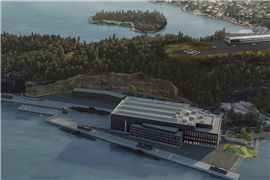Mega infrastructure: dams, bridges and canals
18 November 2008

Many of the largest, most complex and fascinating construction projects throughout the world are all about infrastructure. Steve Skinner looks at a cross section of dam, bridge and canal projects that are underway around the globe.
High rise tower blocks that dazzle with their scale and architectural flamboyance may well grab all the headlines, but the life-blood of these developments and the people that live and work in them is the infrastructure that feeds and supports them.
Brisbane, Australia is a perfect example, where a water supply shortage has prompted a massive enlargement of the Advancetown Lake. Bauer Foundations Australia is raising the height of the Hinze Dam embankment by 15 m to 109 m, and in so doing, increasing the capacity of the lake from 161 billion litres to 309 billion litres.
This massive expansion of capacity should ensure water supply for the Gold Coast region for the next 50 years.
The project involves the installation of a two stage 840 mm thick cut-off wall up to 50 m deep in the existing dam structure. "The construction of the cut-off wall has been a huge challenge," said Gerhard Zylowski, managing director of Bauer Foundations Australia. "To create the space for the cut-off wall, a large amount of material has had to be excavated and half of this material has been extremely hard rock," said Mr Zylowski.
Work on the cut-off wall began in May this year and completion is scheduled for March 2009. Equipment operated on site includes a Bauer BC40 diaphragm wall cutter, a rope-operated grab, a BE500 desanding plant coupled with a BS50 desilter unit, a decanter and a 1000 m3 capacity bentonite mixing unit.
"In order to achieve completion on schedule we're operating double shifts, six days per week," said Mr Zylowski.
Dam reconstruction
Enlarging a dam to increase capacity is one thing, but in the Missouri Ozarks in the US, a catastrophic hydroelectric dam failure on 14 December 2005 saw 1.0 billion gallons (3.8 billion litres) of water discharged in just 12 minutes. The failure saw a 6 m crest of water surge down the Black River causing massive damage to forests and surrounds.
Last winter, AmerenUE began reconstruction of the Taum Sauk dam which, in order to meet safety criteria and Federal Energy Regulatory Commission rulings, necessitated the use of roller-compacted concrete (RCC) for the core of the dam. Overall, the project required more than 2.2 million m3 of concrete, 2 million m3 of which had to be RCC.
"The devil is in the details of this project," said Lee Schermerhorn, vice president of ASI Constructors (a joint-venture contractor on the dam rebuild). "The combination of the upper reservoir soaring 244 m above the hydroelectric plant and pumping and placing concrete into the 241540 m2 of formwork in the upper reservoir has proved most challenging.
"To master the tricky site, we've had to create a delivery method that requires all our machines to work together," continued Mr Schermerhorn. "Integral to this has been the Putzmeister telebelt TB600 telescopic belt conveyor, the TB130 and the 47 m Z fold truck-mounted concrete boom pump."
The dam rebuild is the first project for the TB600 which was only launched this year. "The TB600 is designed to convey the harsh, zero-slump RCC mix," said Mr Schermerhorn. "There's no other way to convey the zero-slump RCC mix as it cannot be pumped, so it's proved invaluable."
By late 2009, Putzmeister will have placed all 2.2 million m3 of concrete necessary for the dam to recommence producing hydroelectric energy for the 2.3 million customers in Missouri and Illinois that rely on the Taum Sauk hydroelectric plant.
Route canals
Placing concrete for canal projects is also an extremely complex challenge and one that Gomaco mastered in lining 16.1 km of the All-American Canal in the Imperial Valley, Southern California, US.
Coffman Specialities, based in San Diego, California won the contract to construct the second and third reaches of the All-American Canal and immediately selected Gomaco to design and build machines that could slipform the canal in just two paving passes.
"We looked at other manufacturers, but Gomaco, in our view, had the best research and development department," said Jim Coffman, project coordinator and operations manager for Coffman Specialities.
"One of the things that drew us to this project was to use current technology and apply it to the paving of the canal prism," continued Mr Coffman. "Gomaco had the commitment to excellence and both the design skills and facilities to enable us to reach our goals."
So tight was the deadline that Gomaco introduced a range of new techniques to the design and manufacturing process in order to complete the machines in time. "We couldn't afford to wait until everything was designed," said Jim Homan, assistant manager of research and development at Gomaco, who passed away following the completion of the canal in April. "Instead we released drawings to the floor as soon as they were available and built the machines in pieces for final assembly later."
The main unit featured a Gomaco GP4000 prime mover set on top of a 3 m tall framework to provide the power plant and control systems. The entire machine was then mounted on four tracks, each 4.2 m long and 762 mm wide.
"Distribution was by way of a paddle system with baffles that ran along the slope of the canal," said Mr Homan. "The paddles moved the concrete down the slope while the baffles collected the concrete to prevent it from sliding to the bottom of the slope. At the same time, a spreader plough moved the concrete across the 7.6 m half section of the canal floor."
Following the paving unit, Gomaco manufactured a water stop machine to insert rubber material into the wet concrete every 4.6 m to prevent fractures. "The speed of progress was dependent on this machine so we built a solution that enabled us to insert one joint every three minutes," said Steve Johnson, senior engineer at Gomaco.
Both machines featured a fixed and hydraulically adjustable end car and powered wedge to match the canal profile.
Across in the Middle East, Limitless has commenced construction on what it considers to be the region's largest, most complex civil engineering project ever, in the shape of the US$ 11 billion, 75 km long Arabian Canal.
The man-made waterway will flow inland from the Dubai waterfront, passing to the east of the new Dubai World Central International Airport before turning back towards Palm Jumeirah. Up to 150 m wide and 6 m deep, the project is expected to take three years to complete.
"The project will create life in the desert," said Saeed Ahmed Saeed, CEO of Limitless. "This is Dubai's most ambitious mega-project yet. It will involve digging and moving more than 1 million m3 of earth every day and will, without question, be one of the wonders of the engineering world."
Indian diamond
While the Middle East starts to create a new waterway, in India the Bandra Worli Sea Link (BWSL), crossing the tidal waters of Mahim Bay, is on schedule for completion in mid-2009.
The BWSL is a 600 m long cable stay bridge linking the northern suburbs of Mumbai with Worli on the south side of the bay. The centrepiece of the bridge is a diamond shaped 125 m central tower. The main cable stay bridge is 500 m in length, but 50 m transition spans on either side extend the reach.
On the Mumbai side of the crossing, the bridge will be served by a new 900 m approach bridge, while on the southern side, a new 1650 m long approach bridge is being constructed. Take into account these approaches and the BWSL is over 3 km in length.
"The foundations for the bridge included 604 large diameter shafts drilled to lengths of between 4 m and 34 m in geotechnical conditions that varied from highly weathered volcanic material to massive high strength rocks," said a spokesman from the Hindustan Construction Company (HCC).
Doka Top 50 large area formwork and SKE100 automatic climbing formwork were selected for the complex diamond shaped central tower to cope with the 100 angle of the upper towers as they inclined towards each other to join at 98 m.
The tower was built to an accuracy of +/- 5 mm, while the cantilever deck was connected to the back span with an accuracy of +/- 5 mm and with an elevation accuracy of +/- 10 mm.
"these achievements in accuracy were the result of systematic planning, accurate detailing of temporary works, careful finalisation of methods and a dedicated and experienced team of engineers working round the clock to build this megastructure," said the HCC spokesman.
Rising expectations
The demand for infrastructure, globally, continues to grow as nations develop and peoples' expectations rise. Ever more complex solutions and technologically developed machinery are being used to meet the challenges of increasingly complicated and large infrastructure projects.
This is a trend that can only really accelerate as demand coupled with ever more adventurous architectural vision will mean that the men and machines behind the world's largest structures will necessarily have to reach and then surpass new boundaries infinitum. And that truly is the excitement of conquering large structures.






